Spatiotemporal Patterns of Crop Irrigation Water Requirements in the Heihe River Basin, China
Abstract
:1. Introduction
2. Research Area and Data Sources
2.1. Research Area
2.2. Data Sources
3. Methods
3.1. Mapping Crop Planting Structure
3.1.1. The Multi-Temporal Normalized Difference Vegetation-Water Index (NDVWI)
3.1.2. Decision Tree Algorithm
3.2. The Thin Plate Spline (TPS) Method
3.3. Effective Rainfall (ER)
3.4. Reference Crop Evapotranspiration (ETo)
3.5. Crop Evapotranspiration under Standard Conditions (ETc)
3.6. Crop Irrigation Water Requirement (IWRc)
4. Results
4.1. Spatiotemporal ER Changes
4.2. Spatiotemporal Changes in Crop Evapotranspiration
4.2.1. Spatiotemporal Changes in ETo
4.2.2. Spatiotemporal Changes in ETc
4.3. Spatiotemporal Changes in IWRc
4.4. The Influence of Changes in Crop Planting Structure on IWRc
5. Discussion
5.1. Reasons for IWRc Changes
5.2. Policy Implications
5.3. The Merits and Drawbacks of this Study
6. Conclusions
Acknowledgments
Author Contributions
Conflicts of Interest
References
- Xu, Q.; Song, W.; Zhang, Y. Forecast and optimal allocation of production, living and ecology water consumption in Zhangye, China. Phys. Chem. Earth 2016, 96, 16–25. [Google Scholar] [CrossRef]
- Li, Z.H.; Deng, X.Z.; Wu, F.; Hasan, S.S. Scenario analysis for water resources in response to land use change in the middle and upper reaches of the Heihe River Basin. Sustainability 2015, 7, 3086–3108. [Google Scholar] [CrossRef]
- Bekchanov, M.; Karimov, A.; Lamers, J.P.A. Impact of water availability on land and water productivity: A temporal and spatial analysis of the case study region Khorezm, Uzbekistan. Water 2010, 2, 668–684. [Google Scholar] [CrossRef]
- Mancosu, N.; Snyder, R.L.; Kyriakakis, G.; Spano, D. Water scarcity and future challenges for food production. Water 2015, 7, 975–992. [Google Scholar] [CrossRef]
- Vorosmarty, C.J.; Green, P.; Salisbury, J.; Lammers, R.B. Global water resources: Vulnerability from climate change and population growth. Science 2000, 289, 284–288. [Google Scholar] [CrossRef] [PubMed]
- Wallace, J.S. Increasing agricultural water use efficiency to meet future food production. Agric. Ecosyst. Environ. 2000, 82, 105–119. [Google Scholar] [CrossRef]
- Song, W.; Pijanowski, B.C. The effects of China’s cultivated land balance program on potential land productivity at a national scale. Appl. Geogr. 2014, 46, 158–170. [Google Scholar] [CrossRef]
- Lee, J.L.; Huang, W.C. Impact of climate change on the irrigation water requirement in northern Taiwan. Water 2014, 6, 3339–3361. [Google Scholar] [CrossRef]
- Deng, X.Z.; Shi, Q.L.; Zhang, Q.; Shi, C.C.; Yin, F. Impacts of land use and land cover changes on surface energy and water balance in the Heihe River Basin of China, 2000–2010. Phys. Chem. Earth 2015, 79–82, 2–10. [Google Scholar] [CrossRef]
- Song, W.; Pijanowski, B.C.; Tayyebi, A. Urban expansion and its consumption of high-quality farmland in Beijing, China. Ecol. Indic. 2015, 54, 60–70. [Google Scholar] [CrossRef]
- Yu, B.H.; Song, W.; Lang, Y.Q. Spatial patterns and driving forces of greenhouse land change in Shouguang City, China. Sustainability 2017, 9, 359. [Google Scholar] [CrossRef]
- Teshager, A.D.; Gassman, P.W.; Schoof, J.T.; Secchi, S. Assessment of impacts of agricultural and climate change scenarios on watershed water quantity and quality, and crop production. Hydrol. Earth Syst. Sci. 2016, 20, 3325–3342. [Google Scholar] [CrossRef]
- Du, Y.H.; Berndtsson, R.; An, D.; Zhang, L.; Hao, Z.C.; Yuan, F.F. Hydrologic response of climate change in the source region of the Yangtze River, based on water balance analysis. Water 2017, 9, 115. [Google Scholar] [CrossRef]
- Ning, T.T.; Li, Z.; Liu, W.Z. Vegetation dynamics and climate seasonality jointly control the interannual catchment water balance in the Loess Plateau under the Budyko framework. Hydrol. Earth Syst. Sci. 2017, 21, 1515–1526. [Google Scholar] [CrossRef]
- Fan, L.; Lu, C.H.; Yang, B.; Chen, Z. Long-term trends of precipitation in the North China Plain. J. Geogr. Sci. 2012, 22, 989–1001. [Google Scholar] [CrossRef]
- Shi, Q.L.; Chen, S.Y.; Shi, C.C.; Wang, Z.; Deng, X.Z. The impact of industrial transformation on water use efficiency in northwest region of China. Sustainability 2015, 7, 56–74. [Google Scholar] [CrossRef]
- Deng, X.P.; Shan, L.; Zhang, H.P.; Turner, N.C. Improving agricultural water use efficiency in arid and semiarid areas of China. Agric. Water Manag. 2006, 80, 23–40. [Google Scholar] [CrossRef]
- De Wit, M.; Stankiewicz, J. Changes in surface water supply across Africa with predicted climate change. Science 2006, 311, 1917–1921. [Google Scholar] [CrossRef] [PubMed]
- Jenerette, G.D.; Larsen, L. A global perspective on changing sustainable urban water supplies. Glob. Planet Chang. 2006, 50, 202–211. [Google Scholar] [CrossRef]
- Song, W.; Deng, X.Z. Land-use/land-cover change and ecosystem service provision in China. Sci. Total Environ. 2017, 576, 705–719. [Google Scholar] [CrossRef] [PubMed]
- Tao, F.L.; Yokozawa, M.; Hayashi, Y.; Lin, E.D. A perspective on water resources in China: Interactions between climate change and soil degradation. Clim. Chang. 2005, 68, 169–197. [Google Scholar] [CrossRef]
- Qi, S.Z.; Luo, F. Water environmental degradation of the Heihe River Basin in arid northwestern China. Environ. Monit. Assess. 2005, 108, 205–215. [Google Scholar] [CrossRef] [PubMed]
- Yang, F.B.; Lu, C.H. Spatiotemporal variation and trends in rainfall erosivity in China’s dryland region during 1961–2012. Catena 2015, 133, 362–372. [Google Scholar] [CrossRef]
- Vorosmarty, C.J.; Willmott, C.J.; Choudhury, B.J.; Schloss, A.L.; Stearns, T.K.; Robeson, S.M.; Dorman, T.J. Analyzing the discharge regime of a large tropical river through remote sensing, ground-based climatic data, and modeling. Water Resour. Res. 1996, 32, 3137–3150. [Google Scholar] [CrossRef]
- Uniyal, B.; Jha, M.; Verma, A. Assessing climate change impact on water balance components of a river basin using SWAT model. Water Resour. Manag. 2015, 29, 4767–4785. [Google Scholar] [CrossRef]
- Van Beusekom, A.E.; Viger, R.J. A glacier runoff extension to the Precipitation Runoff Modeling System. J. Geophys. Res. 2016, 121, 2001–2021. [Google Scholar] [CrossRef]
- Kavvas, M.L.; Chen, Z.Q.; Tan, L.; Soong, S.T.; Terakawa, A.; Yoshitani, J.; Fukami, K. A regional-scale land surface parameterization based on areally-meand hydrological conservation equations. Hydrol. Sci. J. 1998, 43, 611–631. [Google Scholar] [CrossRef]
- Zhou, Q.; Wu, F.; Zhang, Q. Is irrigation water price an effective leverage for water management? An empirical study in the middle reaches of the Heihe River basin. Phys. Chem. Earth 2015, 89–90, 25–32. [Google Scholar] [CrossRef]
- Ge, L.Q.; Li, S.M.; Xie, G.D.; Cheng, Y.P.; Ni, Z.S. The population carrying capacity of waters ecosystem in China. J. Resour. Ecol. 2016, 7, 21–27. [Google Scholar]
- Ye, Q.; Yang, X.G.; Dai, S.W.; Chen, G.S.; Li, Y.; Zhanga, C.X. Effects of climate change on suitable rice cropping areas, cropping systems and crop water requirements in southern China. Agric. Water Manag. 2015, 159, 35–44. [Google Scholar] [CrossRef]
- Shrestha, L.; Shrestha, N.K. Assessment of climate change impact on crop yield and irrigation water requirement of two major cereal crops (rice and wheat) in Bhaktapur district, Nepal. J. Water Clim. Chang. 2017, 8, 320–335. [Google Scholar] [CrossRef]
- Rotich, S.C.; Mulungu, D.M.M. Adaptation to climate change impacts on crop water requirements in Kikafu catchment, Tanzania. J. Water Clim. Chang. 2017, 8, 274–292. [Google Scholar] [CrossRef]
- Luo, X.P.; Xia, J.; Yang, H. Modeling water requirements of major crops and their responses to climate change in the North China Plain. Environ. Earth Sci. 2015, 74, 3531–3541. [Google Scholar] [CrossRef]
- Bocchiola, D. Impact of potential climate change on crop yield and water footprint of rice in the Po valley of Italy. Agric. Syst. 2015, 139, 223–237. [Google Scholar] [CrossRef]
- Shen, Y.J.; Li, S.; Chen, Y.N.; Qi, Y.Q.; Zhang, S.W. Estimation of regional irrigation water requirement and water supply risk in the arid region of Northwestern China 1989–2010. Agric. Water Manag. 2013, 128, 55–64. [Google Scholar] [CrossRef]
- Yang, Y.M.; Liu, D.L.; Anwar, M.R.; O’Leary, G.; Macadam, I.; Yang, Y.H. Water use efficiency and crop water balance of rainfed wheat in a semi-arid environment: Sensitivity of future changes to projected climate changes and soil type. Theor. Appl. Climatol. 2016, 123, 565–579. [Google Scholar] [CrossRef]
- Lu, C.H.; Fan, L. Winter wheat yield potentials and yield gaps in the North China Plain. Field Crop. Res. 2013, 143, 98–105. [Google Scholar] [CrossRef]
- Jin, T.; Qing, X.Y.; Huang, L.Y. Changes in grain production and the optimal spatial allocation of water resources in China. J. Resour. Ecol. 2016, 7, 28–35. [Google Scholar]
- Lang, Y.Q.; Song, W.; Zhang, Y. Responses of the water-yield ecosystem service to climate and land use change in Sancha River Basin, China. Phys. Chem. Earth 2017. [Google Scholar] [CrossRef]
- Deng, X.Z.; Singh, R.B.; Liu, J.G.; Guneralp, B. Water productivity and integrated water resources management. Phys. Chem. Earth 2016, 96, 1. [Google Scholar] [CrossRef]
- Deng, X.Z.; Singh, R.B.; Liu, J.G.; Guneralp, B. Water use efficiency and integrated water resource management for river basin. Phys. Chem. Earth 2015, 89–90, 1–2. [Google Scholar]
- Mamitimin, Y.; Feike, T.; Doluschitz, R. Bayesian network modeling to improve water pricing practices in northwest China. Water 2015, 7, 5617–5637. [Google Scholar] [CrossRef]
- Deng, X.Z.; Zhao, C.H. Identification of water scarcity and providing solutions for adapting to climate changes in the Heihe River Basin of China. Adv. Meteorol. 2015. [Google Scholar] [CrossRef]
- Liu, Y.Q.; Song, W.; Mu, F.Y. Changes in ecosystem services associated with planting structures of cropland: A case study in Minle County in China. Phys. Chem. Earth 2017. [Google Scholar] [CrossRef]
- Liu, Y.Q.; Song, W.; Deng, X.Z. Changes in crop type distribution in Zhangye City of the Heihe River Basin, China. Appl. Geogr. 2016, 76, 22–36. [Google Scholar] [CrossRef]
- Song, W.; Zhang, Y. Expansion of agricultural oasis in the Heihe River Basin of China: Patterns, reasons and policy implications. Phys. Chem. Earth 2015, 89–90, 46–55. [Google Scholar]
- Fu, P.D.; Rich, P.M. A geometric solar radiation model with applications in agriculture and forestry. Comput. Electron. Agric. 2002, 37, 25–35. [Google Scholar] [CrossRef]
- Huete, A.; Didan, K.; Miura, T.; Rodriguez, E.P.; Gao, X.; Ferreira, L.G. Overview of the radiometric and biophysical performance of the MODIS vegetation indices. Remote Sens. Environ. 2002, 83, 195–213. [Google Scholar] [CrossRef]
- Gao, B.C. NDWI—A normalized difference water index for remote sensing of vegetation liquid water from space. Remote Sens. Environ. 1996, 58, 257–266. [Google Scholar] [CrossRef]
- Tayyebi, A.; Pijanowski, B.C. Modeling multiple land use changes using ANN, CART and MARS: Comparing tradeoffs in goodness of fit and explanatory power of data mining tools. Int. J. Appl. Earth Obs. Geoinf. 2014, 28, 102–116. [Google Scholar] [CrossRef]
- Hutchinson, M.F. Interpolation of rainfall data with thin plate smoothing splines: I two dimensional smoothing of data with short range correlation. J. Geogr. Inf. Decis. Anal. 1998, 2, 152–167. [Google Scholar]
- Nagarajan, N.; Poongothai, S. Spatial mapping of runoff from a watershed using SCS-CN method with remote sensing and GIS. J. Hydrol. Eng. 2012, 17, 1268–1277. [Google Scholar] [CrossRef]
- Penman, H.L. Natural evaporation from open water, bare soil and grass. Proc. R. Soc. Lond. Ser. A 1948, 193, 120–145. [Google Scholar] [CrossRef]
- Allan, R.G.; Pereira, L.S.; Raes, D.; Smith, M. Crop Evapotranspiration: Guidelines for Computing Crop Water Requirements; FAO Irrigation and Drainage Paper No. 56; FAO: Rome, Italy, 2005; p. 56. [Google Scholar]
- Smith, P.C.; Calanca, P.; Fuhrer, J. A simple scheme for modeling irrigation water requirements at the regional scale applied to an alpine river catchment. Water 2012, 4, 869–886. [Google Scholar] [CrossRef]
- Han, Z.; Song, W.; Deng, X.Z. Progress in the research on benefit-sharing and ecological compensation mechanisms for transboundary rivers. J. Resour. Ecol. 2017, 8, 129–140. [Google Scholar]
- Jiang, Q.O.; Deng, X.Z.; Zhan, J.Y.; Yan, H.M. Impacts of economic development on ecosystem risk in the Yellow River Delta. Procedia Environ. Sci. 2011, 5, 208–218. [Google Scholar] [CrossRef]
- Davis, K.F.; Seveso, A.; Rulli, M.C.; D’Odorico, P. Water savings of crop redistribution in the United States. Water 2017, 9, 83. [Google Scholar] [CrossRef]
- Jiang, Q.O.; Deng, X.Z.; Zhan, J.Y.; He, S.J. Estimation of land production and its response to cultivated land conversion in North China Plain. Chin. Geogr. Sci. 2011, 21, 685–694. [Google Scholar] [CrossRef]
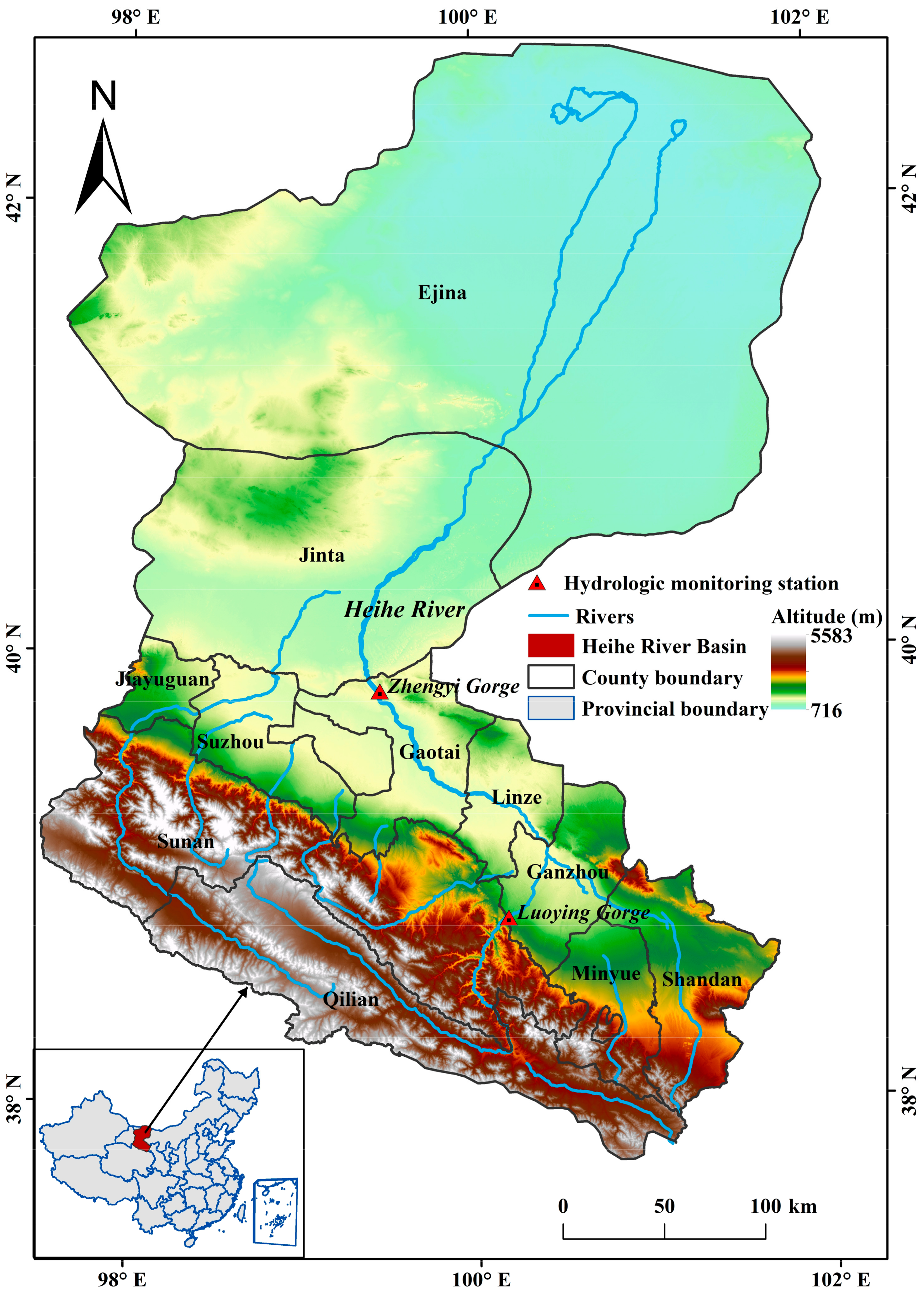

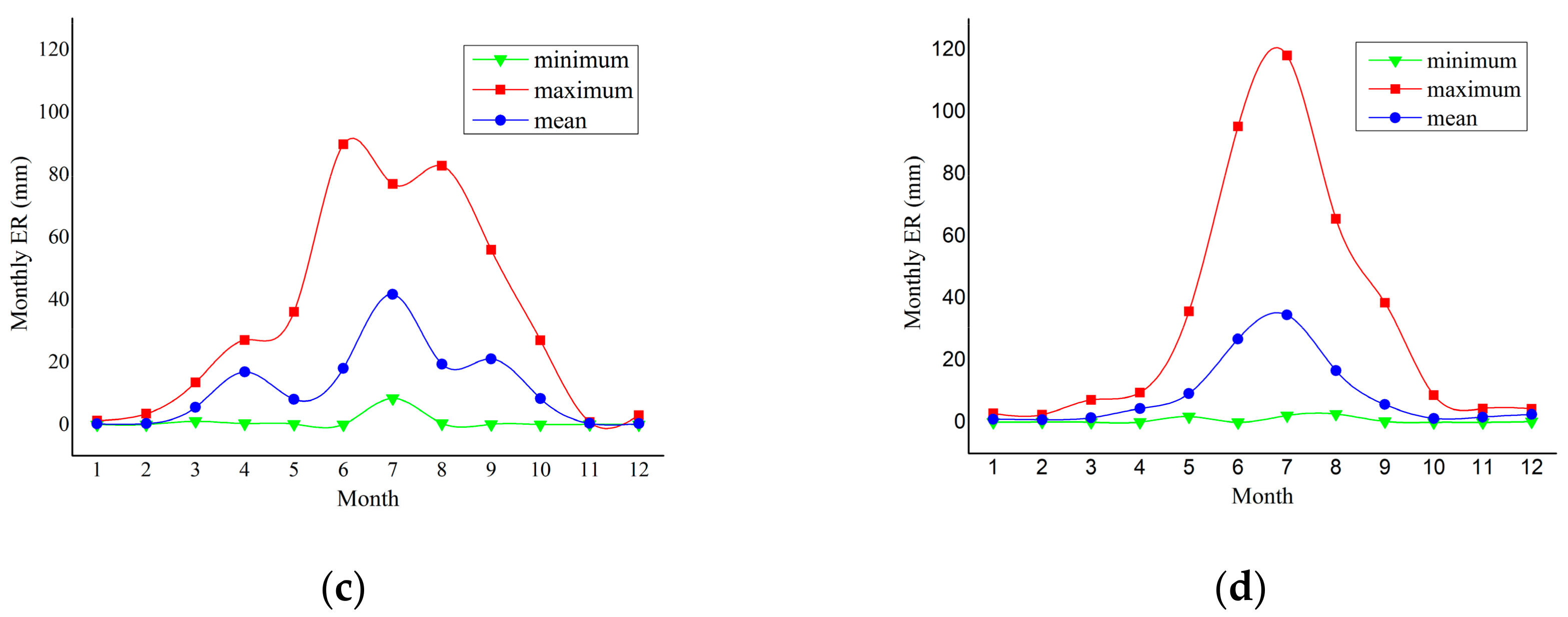


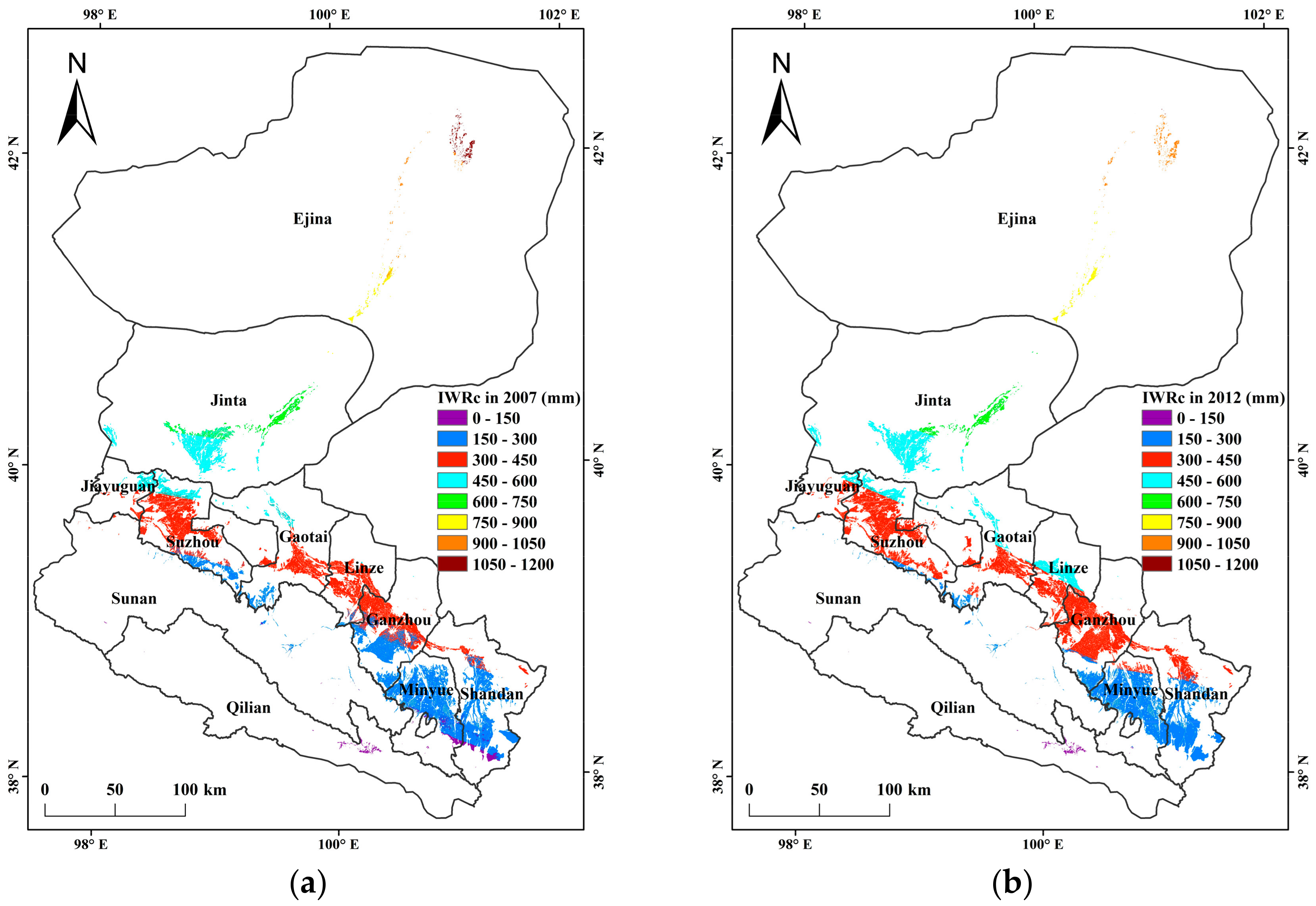
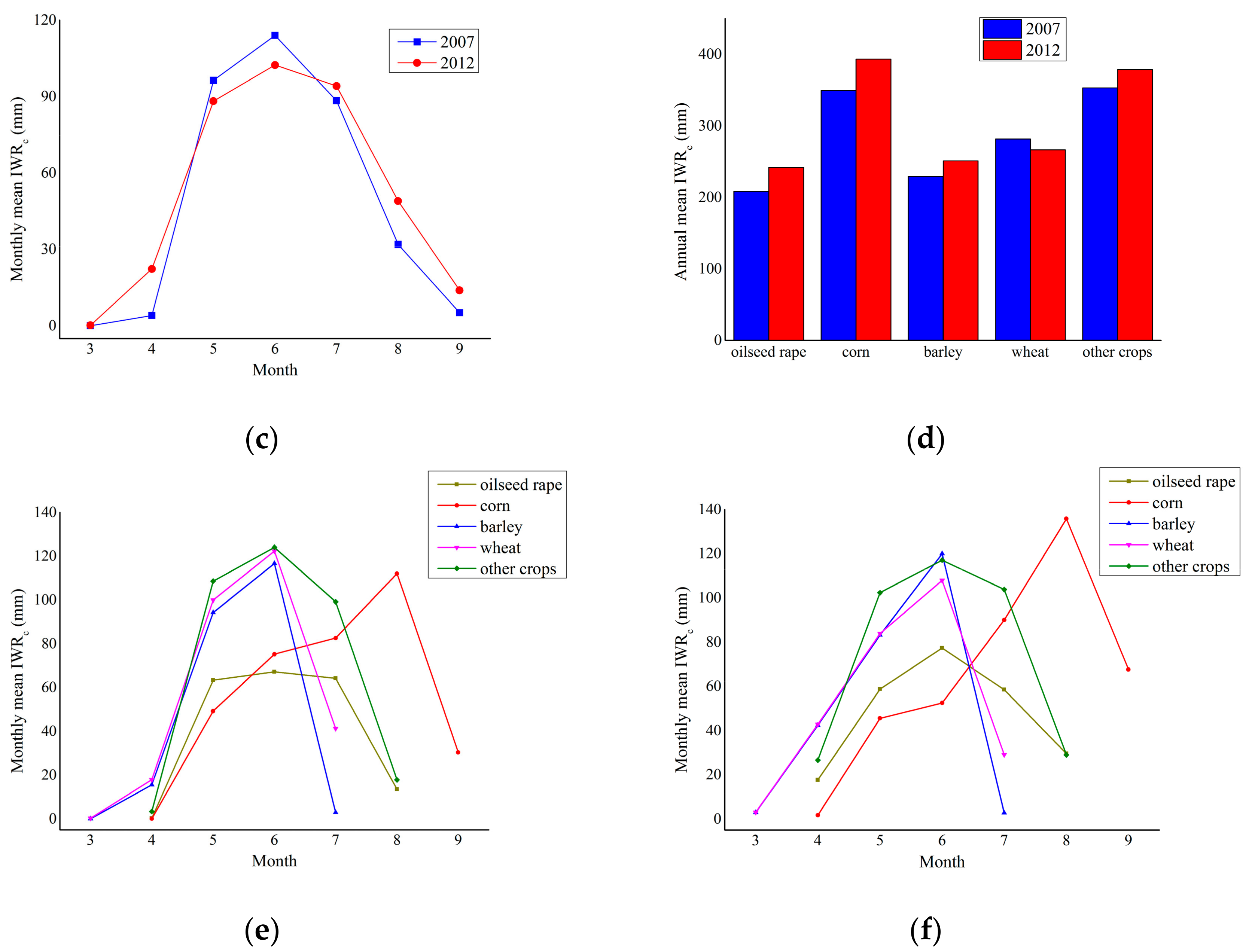
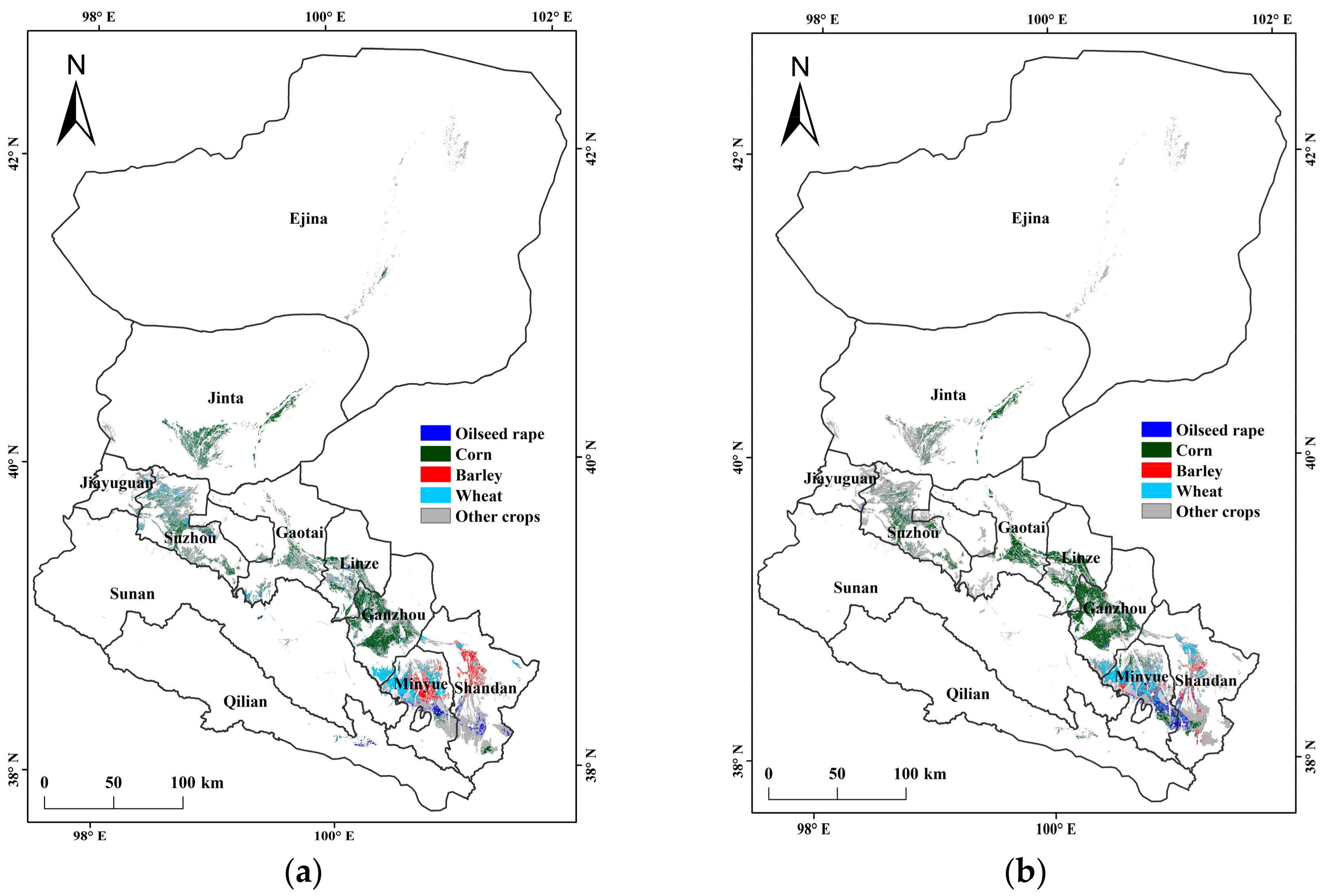
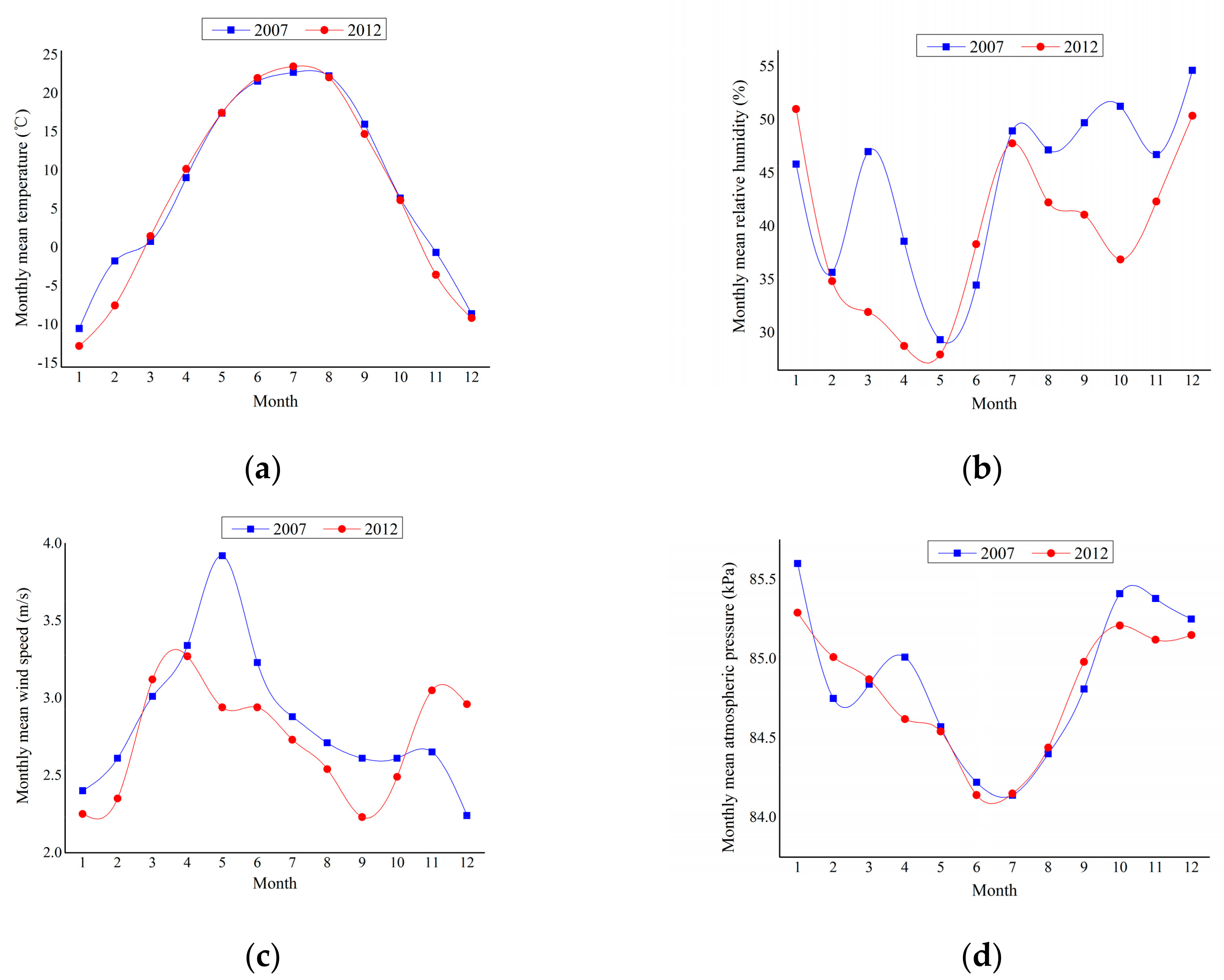
| Crop | Sowing Date | Initial Stage | Development Stage | Mid-Season Stage | End-Season Stage | ||||
|---|---|---|---|---|---|---|---|---|---|
| Duration (d) | Kc ini | Duration (d) | Kc dev | Duration (d) | Kc mid | Duration (d) | Kc end | ||
| Oilseed rape | 10 April | 30 | 0.35 | 36 | 0.73 | 35 | 1.10 | 32 | 0.73 |
| Corn | 15 April | 30 | 0.10 | 56 | 0.56 | 57 | 1.02 | 21 | 0.79 |
| Barley | 20 March | 30 | 0.30 | 43 | 0.78 | 26 | 1.25 | 22 | 0.75 |
| Wheat | 20 March | 30 | 0.30 | 50 | 0.77 | 26 | 1.24 | 22 | 0.77 |
| Others | 1 April | 30 | 0.26 | 46 | 0.71 | 36 | 1.15 | 24 | 0.75 |
| Crop Type | Planting Area (103 ha) | IWRc per Unit Area (m3/ha) | Total IWRc (106 m3) | ||||||
|---|---|---|---|---|---|---|---|---|---|
| 2007 | 2012 | Change | 2007 | 2012 | Change | 2007 | 2012 | Change | |
| Oilseed rape | 16.37 | 20.02 | 3.65 | 2084.35 | 2418.08 | 333.74 | 34.12 | 48.41 | 14.29 |
| Corn | 118.21 | 149.52 | 31.31 | 3493.53 | 3931.04 | 437.51 | 412.97 | 587.77 | 174.80 |
| Barley | 23.51 | 15.43 | −8.08 | 2292.60 | 2511.72 | 219.12 | 53.90 | 38.76 | −15.14 |
| Wheat | 45.92 | 33.68 | −12.24 | 2815.27 | 2666.86 | −148.41 | 129.28 | 89.82 | −39.46 |
| Other crops | 490.34 | 508.85 | 18.51 | 3528.48 | 3788.59 | 260.11 | 1730.15 | 1927.83 | 197.67 |
| Cropland | 694.35 | 727.50 | 33.15 | 3399.45 | 3701.12 | 301.67 | 2360.42 | 2692.58 | 332.16 |
| County | Changes in Crop Planting Area (ha) | Changes of Total IWRc (106 m3) | ||||||
|---|---|---|---|---|---|---|---|---|
| Oilseed Rape | Corn | Barley | Wheat | Other Crops | 2007 | 2012 | Change | |
| Ganzhou | −1157.58 | 12,180.06 | 1418.31 | −4219.29 | 155.09 | 366.24 | 465.25 | 99.01 |
| Minle | 5086.26 | 5924.07 | −6340.59 | 915.30 | 1644.33 | 225.74 | 291.33 | 65.59 |
| Shandan | 405.36 | 2257.65 | −3591.54 | 5092.83 | −2829.03 | 228.86 | 268.39 | 39.53 |
| Linze | −469.62 | 11,941.02 | 8.64 | −2069.64 | −7115.14 | 207.61 | 247.08 | 39.47 |
| Gaotai | −98.82 | 8488.89 | 0.81 | −2062.71 | −4298.19 | 191.43 | 225.80 | 34.37 |
| Sunan | 126.54 | −1125.54 | 52.20 | −511.56 | 10,312.63 | 36.51 | 76.73 | 40.22 |
| Suzhou | 374.13 | 1097.46 | 276.75 | −6805.26 | 6231.75 | 459.84 | 476.00 | 16.16 |
| Jinta | 334.71 | −8135.37 | 53.91 | −1747.80 | 10,678.99 | 418.61 | 424.02 | 5.41 |
| Jiayuguang | 286.20 | −782.73 | 36.18 | −728.10 | 1663.32 | 70.93 | 69.43 | −1.51 |
| Egina | −17.28 | −715.32 | 0.00 | −82.26 | 917.89 | 150.41 | 143.61 | −6.80 |
| Qilian | −1211.58 | 175.50 | 8.64 | −24.39 | 1151.96 | 3.49 | 4.82 | 1.33 |
| Conversion Type | Converted Area (103 ha) | Contribution Value (106 m3) | Contribution Rate (%) | Conversion Type | Converted Area (103 ha) | Contribution Value (106 m3) | Contribution Rate (%) |
|---|---|---|---|---|---|---|---|
| OR to C | 3.70 | 6.83 | 2.06 | B to W | 7.58 | 2.84 | 0.85 |
| OR to B | 1.03 | 0.44 | 0.13 | B to OC | 11.27 | 16.86 | 5.08 |
| OR to W | 1.17 | 0.68 | 0.21 | W to OR | 1.37 | −0.54 | −0.16 |
| OR to OC | 8.16 | 13.91 | 4.19 | W to C | 3.07 | 3.43 | 1.03 |
| C to OR | 2.08 | −2.24 | −0.67 | W to B | 2.43 | −0.74 | −0.22 |
| C to B | 0.44 | −0.43 | −0.13 | W to OC | 26.41 | 25.71 | 7.74 |
| C to W | 0.59 | −0.49 | −0.15 | OC to OR | 13.48 | −14.97 | −4.51 |
| C to OC | 46.25 | 13.65 | 4.11 | OC to C | 72.58 | 29.22 | 8.80 |
| B to OR | 0.85 | 0.11 | 0.03 | OC to B | 8.11 | −8.25 | −2.48 |
| B to C | 0.51 | 0.84 | 0.25 | OC to W | 11.69 | −10.07 | −3.03 |
| Total | 76.77 | 23.11 |
© 2017 by the authors. Licensee MDPI, Basel, Switzerland. This article is an open access article distributed under the terms and conditions of the Creative Commons Attribution (CC BY) license (http://creativecommons.org/licenses/by/4.0/).
Share and Cite
Liu, Y.; Song, W.; Deng, X. Spatiotemporal Patterns of Crop Irrigation Water Requirements in the Heihe River Basin, China. Water 2017, 9, 616. https://doi.org/10.3390/w9080616
Liu Y, Song W, Deng X. Spatiotemporal Patterns of Crop Irrigation Water Requirements in the Heihe River Basin, China. Water. 2017; 9(8):616. https://doi.org/10.3390/w9080616
Chicago/Turabian StyleLiu, Yaqun, Wei Song, and Xiangzheng Deng. 2017. "Spatiotemporal Patterns of Crop Irrigation Water Requirements in the Heihe River Basin, China" Water 9, no. 8: 616. https://doi.org/10.3390/w9080616






